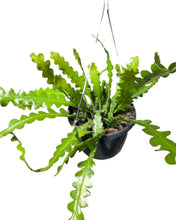
Disocactus anguliger is the accepted name of Epiphyllum anguliger, you may also see this plant labelled as Fishbone cactus.
Disocactus anguliger is part of the Cactaceae family and its native range is SW. & Central Mexico. It’s phylloclades* grow vertically and are almost straight before developing the signature zig-zag shaped stems. These plants have an epiphytic growth habit, tucking their roots into pockets of decaying matter which settle into nooks and crannies of tree branches. They share their habitat with orchids, bromeliads, ferns and mosses. Their tropical environment provides them with lots of warmth and high humidity and most importantly, shading from full sun. These plants produce large, white showy blooms under the right conditions.
Genus name comes from the Greek ‘dis’ meaning twice, this is in reference to the inner and outer flower segments being of the same length. Specific epithet is from the Latin ‘anguli’ meaning angle.
* a special modified photosynthetic stem, having the same function as a leaf.
For more information on Epiphytes, read our blog here.
Light: Bright indirect light, meaning the plant sees the sun for 0-4 hours per day - this could be through trees or a translucent curtain, it’s important for the plant to see the sky in order to thrive. In its natural environment this plant would receive dappled light.
Water: Allow the majority of the mix to dry out. Before watering, ensure the substrate isn’t compacted, if it is, aerate it with a few pokes of a skewer or blunt stick, pour water slowly over the top and allow the water to pass through the drainage holes.
Potting mix: A well draining mix composed of coco coir, perlite or vermiculite, orchid bark and worm castings; you could also add some horticultural charcoal to this epiphytic mix.
Fertilising: Feed your plant with a cactus fertiliser every other watering during the growing season or when you observe active growth. You can dilute fertiliser to half the recommended amount but never add more.
Temperature: 18-26°C, no lower than 12°C.
Humidity: Disocactus would prefer higher humidity but do well to adapt to average home humidity. You can increase humidity by placing the plant on a watered pebble tray or using a humidifier.
Disocactus anguliger are non-toxic.










